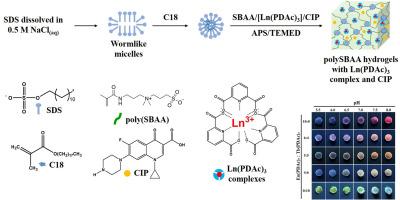多功能聚(亚砜甜菜碱丙烯酰胺)水凝胶集强大的机械性能,ph触发的多色荧光和抗菌功效
IF 4.2
3区 工程技术
Q2 CHEMISTRY, APPLIED
引用次数: 0
摘要
本研究报道了一种基于磺胺甜菜碱丙烯酰胺(SBAA)的多色荧光两性离子疏水缔合水凝胶的开发,用于高级伤口护理。首先,系统地比较了疏水缔合聚甲基丙烯酸亚砜甜菜碱(polySBMA)和聚baa水凝胶的力学性能和自愈能力。由于SBAA中存在酰胺键,促进了额外的氢键相互作用,因此,聚baa水凝胶表现出显著提高的机械强度、抗疲劳性和自愈效率——在90秒内实现近100%的恢复,而聚bma的恢复率约为75%。接下来,将三(2,6-吡啶二羧基)镧系(III)配合物(Ln(PDAc)3)掺入水凝胶基质中。通过调节Eu(PDAc)3/Tb(PDAc)3的比例,水凝胶呈现出可调的多色荧光。此外,通过PDAc配体在不同pH条件下的质子化-去质子化平衡,实现了pH响应荧光行为。在生理相关的pH值5.5-8.0范围内,水凝胶表现出明显的荧光变化,可以直观和实时地监测细菌污染。此外,环丙沙星(CIP)被加载到水凝胶中以赋予抗菌功能。抑菌区实验证实对大肠杆菌和金黄色葡萄球菌具有较强的杀菌活性,并通过离体感染猪皮模型进一步验证了这一结果。总体而言,该工程水凝胶集成了增强的机械性能、快速自愈、ph响应荧光传感和强大的抗菌功效,突出了其作为智能伤口敷料的潜力,能够同时诊断和治疗感染。本文章由计算机程序翻译,如有差异,请以英文原文为准。

Multifunctional poly(sulfobetaine acrylamide) hydrogel integrating robust mechanical properties, pH-triggered multicolor fluorescence, and antibacterial efficacy
This study reports the development of a multicolor fluorescence zwitterionic hydrophobic association hydrogel based on sulfobetaine acrylamide (SBAA) for advanced wound care applications. Initially, the mechanical properties and self-healing capabilities of hydrophobically associated poly(sulfobetaine methacrylate) (polySBMA) and polySBAA hydrogels were systematically compared. Owing to the presence of amide bonds in SBAA, which promote additional hydrogen bonding interactions, the polySBAA hydrogel exhibited significantly improved mechanical strength, fatigue resistance, and self-healing efficiency—achieving nearly 100 % recovery within 90 s, compared to approximately 75 % for polySBMA. Next, tris(2,6-pyridinedicarboxylato)lanthanide(III) complexes (Ln(PDAc)3) were incorporated into the hydrogel matrix. By adjusting the Eu(PDAc)3/Tb(PDAc)3 ratio, the hydrogel exhibited tunable multicolor fluorescence. Furthermore, pH-responsive fluorescence behavior was achieved through the protonation–deprotonation equilibrium of PDAc ligands under varying pH conditions. In the physiologically relevant pH range of 5.5–8.0, the hydrogel demonstrated distinct fluorescence changes, allowing for intuitive and real-time monitoring of bacterial contamination. In addition, ciprofloxacin (CIP) was loaded into the hydrogel to impart antimicrobial functionality. Inhibition zone assays confirmed strong bactericidal activity against E. coli and S. aureus, which was further validated using an ex vivo infected pig skin model. Overall, the engineered hydrogel integrates enhanced mechanical properties, rapid self-healing, pH-responsive fluorescent sensing, and potent antibacterial efficacy, highlighting its potential as a smart wound dressing capable of simultaneous infection diagnosis and treatment.
求助全文
通过发布文献求助,成功后即可免费获取论文全文。
去求助
来源期刊

Dyes and Pigments
工程技术-材料科学:纺织
CiteScore
8.20
自引率
13.30%
发文量
933
审稿时长
33 days
期刊介绍:
Dyes and Pigments covers the scientific and technical aspects of the chemistry and physics of dyes, pigments and their intermediates. Emphasis is placed on the properties of the colouring matters themselves rather than on their applications or the system in which they may be applied.
Thus the journal accepts research and review papers on the synthesis of dyes, pigments and intermediates, their physical or chemical properties, e.g. spectroscopic, surface, solution or solid state characteristics, the physical aspects of their preparation, e.g. precipitation, nucleation and growth, crystal formation, liquid crystalline characteristics, their photochemical, ecological or biological properties and the relationship between colour and chemical constitution. However, papers are considered which deal with the more fundamental aspects of colourant application and of the interactions of colourants with substrates or media.
The journal will interest a wide variety of workers in a range of disciplines whose work involves dyes, pigments and their intermediates, and provides a platform for investigators with common interests but diverse fields of activity such as cosmetics, reprographics, dye and pigment synthesis, medical research, polymers, etc.
 求助内容:
求助内容: 应助结果提醒方式:
应助结果提醒方式:


